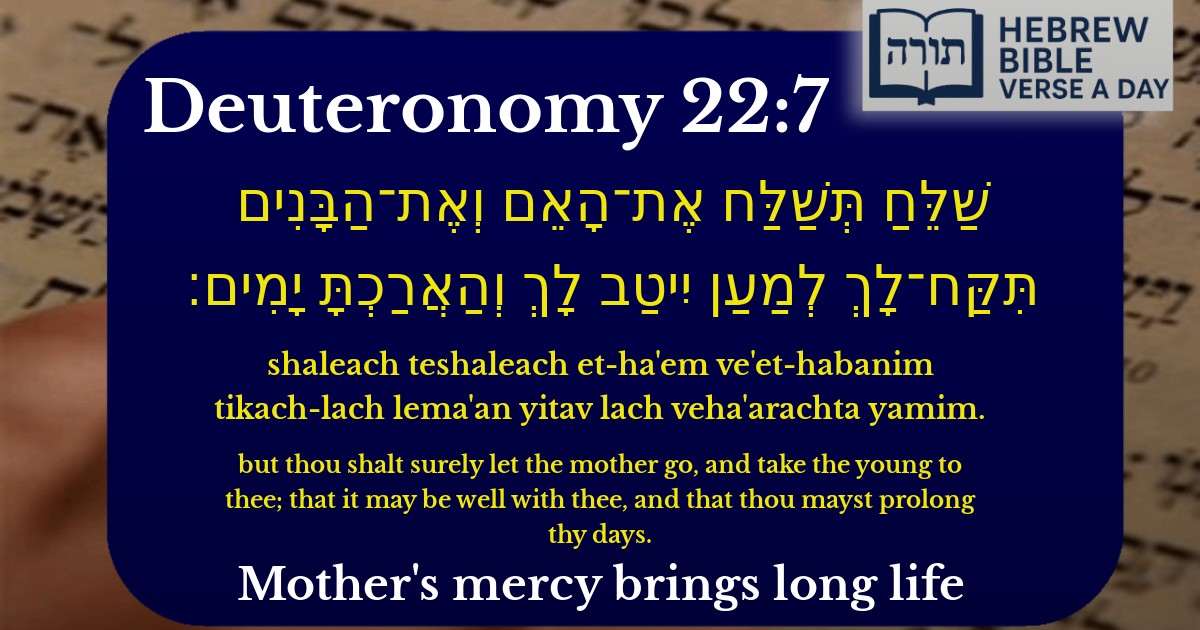Join Our Newsletter To Be Informed When New Videos Are Posted
Join the thousands of fellow Studends who rely on our videos to learn how to read the bible in Hebrew for free!
Hebrew Text
שַׁלֵּחַ תְּשַׁלַּח אֶת־הָאֵם וְאֶת־הַבָּנִים תִּקַּח־לָךְ לְמַעַן יִיטַב לָךְ וְהַאֲרַכְתָּ יָמִים׃
English Translation
but thou shalt surely let the mother go, and take the young to thee; that it may be well with thee, and that thou mayst prolong thy days.
Transliteration
Shaleach teshaleach et-ha'em ve'et-habanim tikach-lach lema'an yitav lach veha'arachta yamim.
Hebrew Leining Text
שַׁלֵּ֤חַ תְּשַׁלַּח֙ אֶת־הָאֵ֔ם וְאֶת־הַבָּנִ֖ים תִּֽקַּֽח־לָ֑ךְ לְמַ֙עַן֙ יִ֣יטַב לָ֔ךְ וְהַאֲרַכְתָּ֖ יָמִֽים׃ {ס}
Parasha Commentary
📚 Talmud Citations
This verse is quoted in the Talmud.
📖 Chullin 139a
The verse is discussed in the context of the mitzvah of sending away the mother bird before taking the young, highlighting its ethical implications and the reward for fulfilling this commandment.
📖 Kiddushin 39b
The verse is referenced in a discussion about the rewards for performing commandments, specifically the promise of long life for sending away the mother bird.


Source and Context
The verse (Devarim 22:6-7) discusses the mitzvah of שילוח הקן (shiluach haken), sending away the mother bird before taking her young. This commandment appears in the Torah alongside other ethical and agricultural laws, emphasizing compassion and restraint in human interaction with nature.
Rashi's Explanation
Rashi (Devarim 22:7) explains that the phrase "שַׁלֵּחַ תְּשַׁלַּח" (shaleach teshalach) uses a double language to indicate that one must send the mother away even multiple times if necessary—until she is completely out of reach. He further notes that the reward for this mitzvah—"לְמַעַן יִיטַב לָךְ וְהַאֲרַכְתָּ יָמִים" (so that it may be well with you and you may prolong your days)—is identical to the reward for honoring one's parents (Shemot 20:12), teaching that both commandments require an act of kindness (chesed) that may seem counterintuitive to human nature.
Rambam's Perspective
In Moreh Nevuchim (3:48), Rambam suggests that this mitzvah instills compassion by preventing cruelty toward animals. He argues that causing unnecessary suffering to a mother bird in front of her young is particularly distressing, and the Torah prohibits such behavior to refine human character.
Talmudic Insights
Midrashic Interpretation
The Midrash Tanchuma (Ki Teitzei 1) connects this mitzvah to the broader principle of Divine mercy: Just as Hashem shows compassion to all creatures, we must emulate His ways. It also notes that the reward of long life is granted because this mitzvah requires overcoming one's natural inclination to seize both the mother and young for immediate gain.
Halachic Application
In Shulchan Aruch (Yoreh De'ah 292), the Rema rules that one should not perform this mitzvah solely for the reward, but rather as an act of obedience to Hashem's will. The mitzvah is only fulfilled if one intends to take the young for a permissible purpose (e.g., food), not wanton destruction.